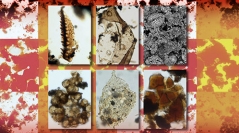

 Geodiversitas
45 (11) - Pages 353-366
Geodiversitas
45 (11) - Pages 353-366The Lower Cretaceous Yamama Formation is well-known as one of the main carbonate oil reservoirs for many of the southern Iraq oilfields. However, its depositional environment has so far been poorly described using palynological techniques. Palynological assemblages from the Lower Cretaceous Yamama Formation in southern Iraq contain variable proportions of non-pollen palynomorphs (NPPs). Although this is the first record of such assemblages from the Cretaceous of Iraq, they appear very diverse and comprise microforaminiferal linings, arthropod cuticles, Botryococcus Kützing, 1849, dinoflagellate cysts, fungal remains, Leiosphaeridia Eisenack, 1958, and Palambages Wetzel, 1961. Palynofacies analyses reveal that samples are generally dominated by AOM and most of them contain smaller quantities of translucent phytoclasts and charcoal. These records, in addition to previous studies, suggest that deposition of the studied strata of the Yamama Formation took place under anoxic conditions in the inner to outer neritic zone in a relatively near-shore setting, as shown by significant terrestrial input.
Leiosphaeridia, Botryococcus, Palambages, dinoflagellates, Yamama Formation, Cretaceous, Iraq, non-pollen palynomorphs, microforaminiferal linings